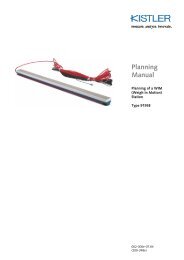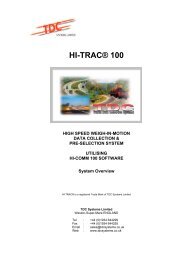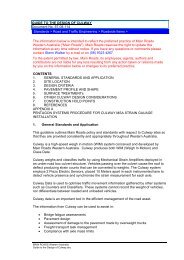Culway WIM Calibration Drift and Normalisation_DTEI
Culway WIM Calibration Drift and Normalisation_DTEI
Culway WIM Calibration Drift and Normalisation_DTEI
Create successful ePaper yourself
Turn your PDF publications into a flip-book with our unique Google optimized e-Paper software.
Department of Transport, Energy <strong>and</strong> Infrastructure<br />
Transport Information Management Section<br />
<strong>Culway</strong> Weigh-In-Motion (<strong>WIM</strong>)<br />
Compensating for ‘<strong>Calibration</strong> <strong>Drift</strong>’<br />
Preliminary Report<br />
CARL CARUANA<br />
Traffic Registrar<br />
February 2006
Introduction<br />
Since the late 1990’s the topic of ‘calibration drift’ has been the subject of various discussions <strong>and</strong><br />
written papers. In particular Mr. R.J.Peters (Main Roads WA) has explored <strong>and</strong> written papers on<br />
calibration drift <strong>and</strong> I am hoping that my research <strong>and</strong> findings will add value to this topic.<br />
I have worked with the <strong>Culway</strong> <strong>WIM</strong> system since 1994 <strong>and</strong> by 1996 I had formed the opinion that<br />
calibration drift existed to some degree or another at all our <strong>Culway</strong> sites. Over the years we have had<br />
to address various problems <strong>and</strong> issues relating to the continuous improvement of our <strong>Culway</strong> sites.<br />
One of the key issues has always been calibration drift - what causes it, <strong>and</strong> what can we do to<br />
compensate for it?<br />
Methodology<br />
By 1997 I was convinced that most of the effects of calibration drift resulted from temperature<br />
variations in the road surface/pavement. <strong>Calibration</strong> drift can also be influenced by other<br />
environmental factors (eg. moisture, wind <strong>and</strong> cloud cover). However, I believe that at the end of the<br />
day it doesn’t matter what causes it, as long as you can recognise when it is happening <strong>and</strong> you have<br />
an effective way of dealing with it <strong>and</strong>/or compensating for it. At the time I did not have a lot of<br />
evidence to support this theory but I still proceeded with developing a method to compensate for what<br />
ever was causing the drift in calibration.<br />
The method I use is based on the average steer axle weights for class 9 vehicles (Type A123 only). As<br />
highlighted by Mr. R.J.Peters the steer weights of type A123 vehicles do not vary much (regardless of<br />
the loading condition). Hence, I firstly calculate the average A123 steer axle weight for each of our<br />
<strong>Culway</strong> sites from data collected during calibration exercises <strong>and</strong> vehicle weighing stations (the<br />
average varies slightly from site to site between 5.5 <strong>and</strong> 5.8 tonnes). These were then used as<br />
benchmark weights for monitoring <strong>and</strong> subsequently ‘normalising’ our <strong>Culway</strong> <strong>WIM</strong> data. I then used<br />
spreadsheets to determine where sensitivity factors (CF1) needed to be adjusted to compensate for<br />
calibration drift. We have now been using this method of ‘normalising’ our <strong>Culway</strong> <strong>WIM</strong> data for the<br />
past 9 years during which time my colleague Roger Bloor has improved the process, by creating new<br />
spreadsheets with additional formulas <strong>and</strong> macros.<br />
The only time that I have experienced calibration drift at a <strong>Culway</strong> site due to moisture was when we<br />
had a temporary drainage problem at one of our sites. Road works had altered the drainage at the site<br />
creating a build up of water on the side of the road. This caused the shoulders <strong>and</strong> road pavement<br />
material to become saturated. The problems at this site were immediately apparent from the <strong>Culway</strong><br />
<strong>WIM</strong> data (even before the road surface/pavement began to fail). As soon as the drainage problem was<br />
rectified <strong>and</strong> the road repaired, the site was recalibrated <strong>and</strong> thereafter we did not experience any<br />
significant calibration drift at this site. From this I concluded that as long as the moisture content in the<br />
base <strong>and</strong> sub-base material of the road pavement can be maintained at a reasonably constant level then<br />
moisture will have very little to do with the drift in calibration.<br />
One could argue about which of the environmental factors contributes most to calibration drift, <strong>and</strong><br />
even though I believe that temperature is the main factor, the key question is - what is the influence on<br />
the strain readings (which is what the calibration factors are applied to)?<br />
The answer is not actually in the temperature or moisture (or any of the other environmental factors) it<br />
is in the road surface/pavement. When we talk about ‘calibration drift’ we should actually be focusing<br />
our attention to the ‘stiffness’ or ‘rigidity’ of the road surface <strong>and</strong> pavement. The rigidity of a flexible<br />
road surface/pavement changes with temperature <strong>and</strong> this has a direct impact on the strain readings.<br />
That is why sites that have a deep asphalt surface can change dramatically as the temperature changes.<br />
<strong>Culway</strong> <strong>WIM</strong> <strong>Calibration</strong> <strong>Drift</strong> <strong>and</strong> <strong>Normalisation</strong>.doc Page 2 of 9
The South East Freeway site near Monarto (SA) is a classic example of this scenario <strong>and</strong> at this point<br />
has been the main focus of this study because we experience our greatest ‘calibration drift’ at this site.<br />
The Westbound kerb lane has a deep asphalt surface of 150 mm (comprising a 35 mm OG10 wearing<br />
course <strong>and</strong> 115 mm AC14). The base course material is 150 mm deep (20 mm dolomite crushed rock)<br />
<strong>and</strong> the sub base is 150 mm deep (20 mm to 40 mm limestone rubble) giving a total depth of 450 mm<br />
of pavement over the culvert.<br />
The following photos are of the AC core sample taken from this site.<br />
The culvert is 2 cells wide (each cell being 3.0 m wide by 2.5 m high) <strong>and</strong> the legal speed limit at this<br />
site is 110 km/h. The site was last calibrated on 6 th April 2004 <strong>and</strong> the following calibration factors<br />
were calculated <strong>and</strong> consistently used for this study of the Monarto Westbound kerb lane:<br />
Sensitivity (CF1) = 0.035869<br />
Power Law (CF2) = 1.001615<br />
Unit Influence Line (CF3) = 3.4<br />
Steer Factor (CF4) = 1.1<br />
In September 2004 we installed a small temperature recorder (‘T-TEC 6’ Temperature Data Logger) at<br />
the Monarto <strong>Culway</strong> site. Two temperature probes were also installed. The first was installed about 70<br />
mm below the asphalt surface (to give pavement temperature) <strong>and</strong> the second in the shade near the end<br />
of the culvert (to read the ambient temperature).<br />
When it comes to drawing any conclusions <strong>and</strong>/or making any adjustments to Weigh-In-Motion data<br />
based on temperature I believe that the pavement temperature is the key element, <strong>and</strong> should be used in<br />
preference to ambient temperature.<br />
Results<br />
We have collected over twelve months of temperature data from this site <strong>and</strong> plotted it against the steer<br />
axle weights of Class 9 (Type A123) vehicles. Even though there are some gaps in the data (due to<br />
battery <strong>and</strong> equipment failure) we still have sufficient data to show the correlation between<br />
temperatures <strong>and</strong> steer axle weight.<br />
The following chart (Chart 1) shows the correlation of temperature data against the average steer axle<br />
weights (at half hour intervals) for the whole period of the study (September 2004 – October 2005).<br />
<strong>Culway</strong> <strong>WIM</strong> <strong>Calibration</strong> <strong>Drift</strong> <strong>and</strong> <strong>Normalisation</strong>.doc Page 3 of 9
Chart 1 – Annual Temperature Vs Steer Axle Weights<br />
Note that the vertical scales of the charts in this report are not labelled but the legend describes the<br />
units that correspond/apply to weight (Tonnes) <strong>and</strong> temperature (Celsius).<br />
Chart 1 demonstrates that there are basically two distinct cycles (the 12-month annual temperature<br />
cycle <strong>and</strong> the 24-hour daily temperature cycle). However, it does not give enough detail to compare<br />
specific steer axle weights to the corresponding pavement temperature <strong>and</strong> ambient temperature.<br />
The next two charts (Chart 2 <strong>and</strong> Chart 3) zoom into a typical summer week in January 2005 <strong>and</strong> a<br />
typical winter week in July 2005. This provides sufficient detail to be able to clearly see that the rise<br />
<strong>and</strong> fall in steer axle weights directly corresponds to the rise <strong>and</strong> fall in temperature. It also<br />
demonstrates the difference between pavement temperature <strong>and</strong> ambient temperature, where changes<br />
in pavement temperature lag behind changes in ambient temperature. I put this down to all the other<br />
environmental factors (eg. wind, rain <strong>and</strong> cloud cover) that have an almost instant effect on the<br />
atmosphere but may take some time to have the same effect on the pavement. Chart 2 clearly<br />
demonstrates the variations that can occur within the same week. The day-to-night variations are also<br />
very evident. However, Chart 3 shows that for a typical winter week (July 2005) the temperatures are<br />
relatively stable <strong>and</strong> therefore the steer axle weights are far more consistent.<br />
<strong>Culway</strong> <strong>WIM</strong> <strong>Calibration</strong> <strong>Drift</strong> <strong>and</strong> <strong>Normalisation</strong>.doc Page 4 of 9
Chart 2 – Typical Summer Week<br />
Chart 3 – Typical Winter Week<br />
<strong>Culway</strong> <strong>WIM</strong> <strong>Calibration</strong> <strong>Drift</strong> <strong>and</strong> <strong>Normalisation</strong>.doc Page 5 of 9
The next two charts provide even more detail. Chart 4 zooms in on a typical day in summer (January<br />
2005) followed by Chart 5 showing a typical day in winter (July 2005).<br />
Chart 4 – Typical Summer Day<br />
Chart 5 – Typical Winter Day<br />
<strong>Culway</strong> <strong>WIM</strong> <strong>Calibration</strong> <strong>Drift</strong> <strong>and</strong> <strong>Normalisation</strong>.doc Page 6 of 9
Chart 5 clearly shows that the steer axle weights are far more consistent during a winter’s day than a<br />
summer’s day (Chart 4). This is because the daily temperature variations are smaller during winter. As<br />
the variation in temperature increases so does the variation in steer axle weights. More importantly, the<br />
variations are consistent. It is also important to note that even though the weights are more consistent<br />
on a winter’s day they may still need to be ‘normalised’ to bring them up to the st<strong>and</strong>ard benchmark<br />
weight for the site. This is necessary because the calibration factors for each site are based on<br />
information that was collected on a specific day where the temperature may have been quite different<br />
on that day. This is why we generally try to undertake our calibrations during spring or autumn (more<br />
neutral conditions, where hopefully the daily temperature will not vary much during the course of the<br />
day).<br />
The next issue in this study is to prove that there is a similar relationship between temperature <strong>and</strong> the<br />
Gross Vehicle Mass (GVM). However, this may not be as obvious due to the wide range of loads that<br />
are possible with Class 9 vehicles (from empty, at about 17 tonnes to fully loaded at 45.5 tonnes for<br />
vehicles fitted with road friendly suspension). Despite the assumed difficulty in being able to<br />
demonstrate this, the next chart (Chart 6) does suggest that the GVM has the same relationship with<br />
temperature as the steer axle weights. This provides further evidence that axle weights (strain readings)<br />
are proportional to the temperature within the road surface/pavement (the degree of influence depends<br />
on the composition of the road pavement, which varies from site to site).<br />
Chart 6 – Annual Temperature Vs Gross Vehicle Mass<br />
The scatter of GVM beyond what is normally expected for Class 9 (A123 type) vehicles demonstrates<br />
how necessary it is for us to ‘normalise’ the data from this site. At this stage it would be reasonable to<br />
assume that all vehicles weighed at this site are producing results that are also influenced by<br />
temperature. It should also be noted that our normalisation procedure does not compensate for<br />
variations in the daily temperature (over a 24 hour period). Compensating for daily/hourly variations in<br />
temperature is more difficult to achieve. This would require a much more sophisticated method of<br />
normalising the data. At the time this report was written we only had ‘normalised’ data for 2004.<br />
Hence, Charts 7 <strong>and</strong> 8 will show how (for the 2004 dataset) the mean steer axle weight <strong>and</strong> mean gross<br />
<strong>Culway</strong> <strong>WIM</strong> <strong>Calibration</strong> <strong>Drift</strong> <strong>and</strong> <strong>Normalisation</strong>.doc Page 7 of 9
vehicle mass have been flattened (to compensate for the seasonal variation between the summer <strong>and</strong><br />
winter months).<br />
Chart 7 – Temperature Vs Normalised Steer Axle Weights<br />
Chart 8 – Temperature Vs Normalised Gross Vehicle Mass<br />
<strong>Culway</strong> <strong>WIM</strong> <strong>Calibration</strong> <strong>Drift</strong> <strong>and</strong> <strong>Normalisation</strong>.doc Page 8 of 9
Where to from here?<br />
I am proposing to undertake further temperature studies of some of our other (more typical) <strong>Culway</strong><br />
sites. I will need to do this in order to see how sensitive to temperature they are in comparison to the<br />
Monarto site. This will probably include two more sites, one with deep asphalt (similar to Monarto)<br />
<strong>and</strong> the other having a simple spray seal (chip seal). We have recently started to improve the road<br />
surface quality at some of our <strong>Culway</strong> sites by having asphaltic concrete laid over our sites. This not<br />
only improves the road surface but also improves the reliability <strong>and</strong> quality of piezo installations. I will<br />
be paying particular attention to these sites to see how much influence the 75 – 100 mm AC has had on<br />
the ‘calibration drift’ at these sites (I would expect that calibration drift may increase at these sites).<br />
I have partially developed a program that will read raw <strong>Culway</strong> data (*.CRD files) <strong>and</strong> the<br />
corresponding temperature data files, with the aim of correlating each weighed vehicle to temperature<br />
readings at half hourly intervals. The next step would be to prepare a table containing ‘temperature<br />
compensation factors’ <strong>and</strong>/or establish an empirical relationship, which could be produced from the<br />
temperature information collected, <strong>and</strong> correlating it to the steer weights of Class 9 vehicles.<br />
As you may imagine this is tedious, <strong>and</strong> it takes a long time to gather <strong>and</strong> correlate all the necessary<br />
data for each site. So this is not necessarily the best way to apply vehicle-by-vehicle temperature<br />
compensation factors. My main objective is to show that there is a need to improve the quality of<br />
<strong>Culway</strong> <strong>WIM</strong> information <strong>and</strong> to demonstrate that a method to compensate for temperature can be<br />
developed. However, (if my findings are justified <strong>and</strong> supported by other State Road Authorities) the<br />
ultimate solution would be to incorporate temperature sensors as part of the <strong>Culway</strong> <strong>WIM</strong> system. This<br />
would allow temperature data to be logged against each vehicle weighed. The calibration <strong>and</strong> analysis<br />
programs could then be modified/upgraded to use temperature data by locating <strong>and</strong> applying a suitable<br />
factor from a predefined ‘temperature compensation factor table’ <strong>and</strong>/or applying an empirical<br />
relationship.<br />
I may be dreaming!<br />
But you’ll never, never know! …… If you never, never have a go! ☺<br />
<strong>Culway</strong> <strong>WIM</strong> <strong>Calibration</strong> <strong>Drift</strong> <strong>and</strong> <strong>Normalisation</strong>.doc Page 9 of 9
















